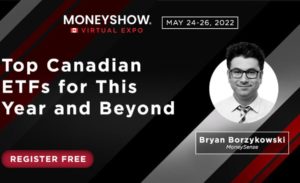MoneySense has just published its annual feature, the ETF All-Stars 2022. For the first time in several years, I was not the lead writer on this package although I was involved in my role as Investing Editor at Large. We passed the writing reins to veteran financial freelance writer Bryan Borzykowski, who has previously written MoneySense’s annual Robo-advisor feature and is currently writing a new book to be titled ETFs for Canadians for Dummies.
As I point out in another MoneySense column, there is another ETF book published in 2021 that makes a good complement to the All-Stars package. Reboot Your Portfolio is written by Dan Bortolotti of PWL Capital. Dan was the lead writer of the first edition of the ETF All-stars and served as a panelist for several subsequent years, along with his PWL colleague Justin Bender. In recent years, PWL advisors Ben Felix and Cameron Passmore have served as some of the panelists responsible for selecting the All-stars. The team of 8 panelists is unchanged from last year.
You can find the new edition of the All-stars by clicking here: Best ETFs in Canada for 2022.
As Bryan points out in his overview, by design, the panel didn’t make that many changes from previous years. The idea all along has been to provide a bunch of core low-cost, broadly diversified ETFs that don’t need to be changed every year. Certainly, the panel has never felt obliged to recommend brand new “theme” ETFs just for the sake of change.
Here’s my summary of the main changes:
Canadian Equities
No changes to last year’s lineup.
US Equities
The panel dropped the list of US equity ETFs from ten last year to seven this year.
International Equities
Last year’s picks return, plus the panel added three Emerging Markets ETFs: XEC, ZEM and EMXC.
Fixed Income
While Fixed Income has been a languishing asset class in recent months, the panel didn’t view this as alarming. Its previous lineup of Bond ETFs returns largely intact, with just one casualty: the panel decided to remove the Vanguard Global Bond ETF (VGAB.) For those who are nervous about more losses from rising interest rates, it continues to emphasize short-term bond ETFs like VSB and XSB
Note that in my recent MoneySense Retired Money column on the alleged Death of Bonds, I quote panelist Ben Felix, who still sees a role for fixed income in diversified portfolios. My column suggests those worried by rising rates can either park in treasury bills and wait for further interest rate hikes later this year, or ladder 1- and 2-year GICs every few months. Several 1-year GICs now pay close to 3%. That may be below the rate of inflation of late but at least its beats losses of near 10% sustained by aggregate bond ETFs.
Bryan also passed along this quote from Felix: “We also have to keep in mind that bond prices already fell based on the market’s expectations for future rate increases … The market priced in rate hikes well before the Bank of Canada hiked, not after. On the date of the BoC announcement bond returns were positive. This does not mean that bond prices can’t fall further, but nobody knows that will happen. If an asset class has been declared dead, it’s probably a great time to invest in it.”
Well said!
All-in-one ETFs
No changes to the existing line-up of 15 Asset Allocation ETFs, an asset class pioneered by Vanguard Canada and soon imitated by BMO ETFs, iShares and Horizons. Fidelity Canada recently entered this field and also adopted a similar ticker strategy with symbols like FBAL and FGRO. The new wrinkle is adding 2 or 3% positions in cryptocurrency but for that reason, a majority of the panel opted not to include Fidelity’s All-in-one ETFs as All-stars this time around.
While it didn’t seem to be an issue for the panel, I’d point readers to the Fixed-income section for those who are concerned about interest-rate risk and aggregate bond ETFs that hold too many long-duration bonds. Ironically, the more conservative AA ETFs are likely to hold more aggregate bond ETFs. One alternative might be to switch to a half portion of pure equity AA ETFs (like Engen’s pick, VEQT) and use short-term bond ETFs and/or 1- or 2-year GICs for the fixed-income exposure.
As there seems to be some confusion as to what we mean by Desert Island picks, let me recap the original rationale when we introduced this category a few years back. I’ve long listened to the Motley Fool podcasts and they often talk about Desert Island stocks: a single pick that you’d be comfortable owning for years if you were stranded on a desert island and were unable to reach your broker to make any changes. Actually, I’d argue desert-island ETFs make a lot more sense than single stocks. If I had to pick a stock, it would be Berkshire Hathaway or the CDR version of same now trading on the Neo exchange. In this spirit, panelist Robb Engen is sticking with what he puts his own personal money in: VEQT or Vanguard’s 100% stocks Asset Allocation ETF.
Also standing pat this year is Dale Roberts, who again picked the Purpose Bitcoin ETF (BTCC), and Ioulia Tretiakova, with BMO’s low-volatility ZLB.
Mark Yamada made a slight change, replacing HXQ with Invesco NASDAQ NextGen 100 Index ETF (QQJR.TO).
Yves Rebetez also changed his pick but is sticking with his theme of futuristic technology, moving from NXTF (a fifth-generation ETF) to the Global X Internet of Things ETF (SNSR).
Mark Seed made a new pick: the First Trust NASDAQ Clean Edge Green Energy Index Fund (QCLN).
Over at PWL, Ben Felix stuck with his previous pick of Avantis International Small Cap Value ETF (AVDV); However, colleague Cameron Passmore has moved from the Avantis camp to that of Dimensional Fund Advisors and DFA Dimensional US Small Cap Value ETF (DFSV.)
MoneyShow virtual event
 For more on the ETF All-stars, Bryan Borzywowski is also featured in a virtual event by the MoneyShow, which started running on May 24th and continues until May 26th. As you can see by the accompanying image, registration is free.
For more on the ETF All-stars, Bryan Borzywowski is also featured in a virtual event by the MoneyShow, which started running on May 24th and continues until May 26th. As you can see by the accompanying image, registration is free.




